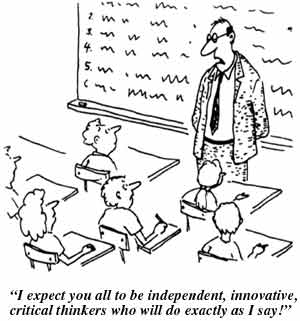Extended Comments- Mary Abby's Blog
I agree with Mary Abby regarding Shor's argument. Shor feels as though it is necessary to include the students into the curriculum. Meaning students learning strategies and backgrounds should be taken into account in order to provide an engaging classroom. Also Shor points out that teachers should indeed allow their students to question what they are learning. By doing this the students are engaging in critical thinking and are able to retain the information they are learning. They actually learn and are able to understand what they are learning. Why? Because they're not just using memorization to learn the information.
funding is another political dimension of education, because more money has always been invested in the education of upper-class children and elite collegians than has been spent on students from lower-income homes and in community colleges.
While reading the article I had also highlighted this quote and found it in Mary Abby's blog. When reading this quote it reminded be of multiple other articles we read this semester. But I immediately thought about Kristoff. I thought about the different education that many of these students receive due to funding, the inequality in these students education is institutional. I also thought about Finn because it reminded me of the different types of education students received depending on what schools they attended: elite, working class, etc.
Mary Abby's 2nd Quote was interesting because it reminded me that the maintenance of the facilities is also important. A facility that jeopardizes a child's health can also hinder their development and their education. While I read this quote it reminded me of the high school I attended. The school actually moved and got a new head of the school. I received a link from my high school teacher that updated us about the changes that occurred and the situation that the school was in.
Schools need to be defended as an important public service that educates students to be critical citizens who can think, challenge, take risks, and believe that their actions will make a difference in the larger society.I really love this because I feel like this is what Shor wanted to communicate to us. Also this quote reminds me of what we do in this class. This class MAKES US THINK, CHALLENGES OUR BELIEF'S, ALLOWS US TO TAKE RISKS, AND WHAT WE ARE LEARNING WILL HAVE AN EFFECT ON OUR EXPERIENCES AS TEACHERS.
While reading this article I also kept thinking about Delpit, Christensen, and August. Delpit's first aspect of power:
Issues of Power are enacted in the classroom
We see this because the teacher is the one that has the power in a classroom. But Shor wants students to also have some power. POWER to challenge what they're learning and take part in the classroom. Which also reminds me of Christensen. Christensen was also present because she wanted students to find ways to talk back and if students were oppressed they should talk back. Also August's Safe Spaces was present because as you engage students (or take them into account) you create an atmosphere where students are actually able to talk and provide their opinions and answers.

